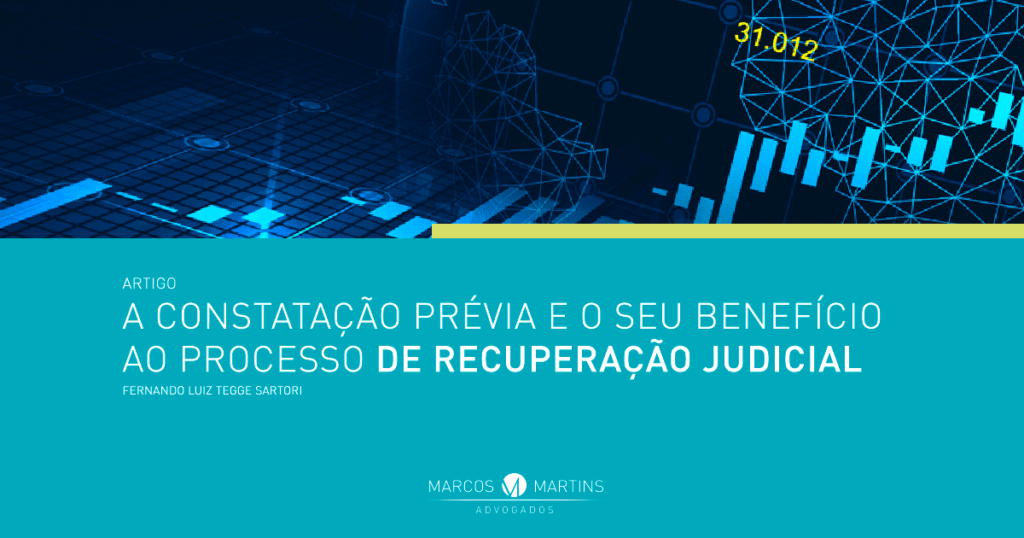
Fernando Luiz Tegge Sartori
Lawyer at Marcos Martins Advogados
The judicial reorganization process is a legal alternative for companies that are going through difficult times and that have been unsuccessful in restructuring the company through out-of-court negotiations and administrative measures, with a view to collective negotiations supervised by the judiciary to restructure the company. (SARTORI, 2019)[1].
This restructuring of the company, through Judicial Reorganization, requires the company to meet a series of requirements in order for its request to be granted by the court in which the proceedings are taking place, especially with compliance with the requirements of articles 48[2] and 51[3], both of Law 11.101/2005. (SARTORI, 2019)
Based on the legislation, once the requirements of articles 48 and 51 of law 11.101/2005 have been met, the judge will grant the processing of the Judicial Recovery, under the terms of article 52 of law 11.101/2005[4].
However, despite the absence of a legal provision to this effect, it has become increasingly common in Judicial Reorganization proceedings to carry out a prior expert opinion, recently renamed by the CNJ as a “prior finding”, on companies applying for Judicial Reorganization, regardless of whether they meet all the requirements listed in the law.
Because there is no express legal provision, the prior finding is justified by those who defend its application to Law 11.101/2005, by virtue of an extensive interpretation of article 52 of Law 11.101/2005 to the entire reorganization system, in order to guarantee its efficiency and purpose. The formal and objective analysis referred to in the wording of article 52 of the LRF, in the view of those who defend the incorporation of prior expertise into the reorganization system, would prevent the verification of the consistency of the documents presented by the debtor in its request for Judicial Reorganization.
This prior examination, when it is carried out, is ordered by the judge, during the time between the filing of the request for judicial reorganization and the decision to grant processing of the Judicial Reorganization.
The purpose of the preliminary examination is to ascertain the activities of the company that is applying for judicial reorganization in order to renegotiate its debts subject to the Judicial Reorganization process, at which time the expert appointed by the court to carry out the work must go to the company’s headquarters and branches and present a technical report on the situation of the company he has witnessed.
The main idea is to avoid granting a judicial reorganization to a company that is no longer active, that has no business activity and that uses the request for judicial reorganization for purposes other than the objective of the legislation.
In a cold analysis, the idea of this prior finding seems to make a lot of sense, in order to enforce the objective of the reorganization system, giving greater security to the Court when it makes the decision to grant the processing of the Judicial Reorganization, as well as to the creditors and other interested parties in the Judicial Reorganization process.
In the same vein, the National Council of Justice recently approved a recommendation that due diligence be carried out on the documents and activities of companies applying for Judicial Reorganization, with the aim of ensuring that the companies have complied with the formal requirements of the application for Judicial Reorganization and that they are active.
However, while on the one hand prior expertise aims to guarantee security for the court and interested creditors, on the other hand it can cause the crisis to worsen or even lead to the request for judicial reorganization being rejected.
This is because it is not uncommon for the reorganization court to take too long to analyze the Judicial Reorganization request and issue its decision, which may be a decision to grant the request or a decision ordering a prior expert opinion.
Similarly, practice shows that the time lapse between the decision ordering a preliminary examination and the decision granting the Judicial Reorganization is very long, especially in inland courts, outside the country’s major cities and capitals. Due to the lack of legal provisions, judges apply different deadlines for the work to be completed, which usually vary between 5 and 15 days.
In a recent publication, based on research carried out by the Insolvency Observatory of the Center for the Study of Insolvency Processes – NEPI of PUC/SP and the Brazilian Association of Jurimetry – ABJ[5] – in Judicial Reorganization cases distributed before the specialized courts of the Capital of the State of São Paulo – the authors concluded that when prior expertise was determined in a request for Judicial Reorganization, the median time until the decision to grant processing increased by 25 days.
In addition, this study found that the likelihood of success in the granting of judicial reorganization processing, when preceded by prior expertise, is greater than in cases where no expertise was ordered, although there is no proof that companies that underwent expertise were more successful in the Judicial Reorganization than companies that were not previously investigated.
Although the idea of prior verification is to provide greater security for those interested in the process, in many cases the consequences can be devastating for the companies subjected to it, even though the chances of success in processing the request for Judicial Recovery increase, according to a study carried out by the insolvency observatory of the Center for Studies of Insolvency Processes – NEPI of PUC/SP and the Brazilian Association of Jurimetry – ABJ.
A company that decides to file for Judicial Reorganization, more than ever, depends on the agility of the judiciary so that it can take advantage of the benefits of the legislation, especially the protection against lawsuits and executions – the stay period.
Practice shows that the determination of prior diligence is not a guarantee of a greater likelihood of success for the Judicial Reorganization, while, contrary to the noble objective it serves, it seems to us that it tends to make the company’s situation even worse in the market.
With the distribution of the Judicial Reorganization request, the debtor tends to find it more difficult to negotiate with its suppliers and faces difficulties in accessing credit, a difficulty that is substantially worsened as the period until the decision to grant the Judicial Reorganization is extended, which reaches 25 days on average – considering that the data was collected from specialized courts. Until its request is granted, the debtor company lives in limbo, given the uncertainty of the success of its request in the eyes of the market.
In this context, it seems to us that when analyzing the request for judicial reorganization, the judge should conduct a formal analysis of the documentation presented by the debtor, applying the objectivity that the law imposes in its article 52, in the sense that “If the documentation required in article 51 of this Law is in order, the judge will grant the processing of the judicial reorganization”.
Practice shows that many technically bankrupt companies, if subjected to a cold analysis of their balance sheet or cash flow, have had successful judicial reorganizations, given that the business environment provided by the reorganization system allowed the approval of the Judicial Reorganization Plan and the consequent preservation of business activity and jobs.
The determination of the diligence of the prior expert opinion could be put to better use and its purpose enforced when there is doubt as to the existence of the business activity, especially in cases where the requirements of articles 48 and 51 of Law 11.101/2005 have not been met and it is necessary to amend the initial petition. In this case, the expertise would clearly serve to provide the court with certainty and without delaying the processing of the Judicial Reorganization, since the delay was caused by the debtor himself.
Likewise, it makes no sense to request a prior examination of a company that has complied with all the legal requirements and which is of great importance to society or the community in which it is established and which is known to be in full activity, on which occasion a prior examination would be of no benefit to those involved in the process.
For all the above reasons, it seems to us that the designation of prior verification in Judicial Reorganization proceedings should not be used indiscriminately, as it would be more useful in cases of real doubt as to the activities of the company that intends to avail itself of the benefits of the legislation.
Marcos Martins Advogados is always attentive to doctrinal and jurisprudential discussions in order to provide the best possible service to its clients.
[1] SARTORI, F. L. T. O papel do juiz no processo de recuperação judicial. Marcos Martins Advogados, 2019. Available at https://www.marcosmartins.adv.br/pt/papel-do-juiz-processo-recuperacao-judicial/. Accessed on: November 4, 2019.
[2] Article 48. A debtor may apply for judicial reorganization if, at the time of the application, it has been carrying on its business regularly for more than two (2) years and meets the following requirements, cumulatively: I – they are not bankrupt and, if they are, the liabilities arising therefrom have been declared extinct by a final judgment; II – they have not been granted judicial reorganization for less than five (5) years; III – they have not been granted judicial reorganization for less than five (5) years on the basis of the special plan referred to in Section V of this Chapter; IV – they have not been convicted or do not have, as a manager or controlling shareholder, a person convicted of any of the crimes provided for in this Law. § Paragraph 1 – Judicial reorganization may also be requested by the surviving spouse, heirs of the debtor, executor or remaining partner. § Paragraph 2. In the case of rural activity by a legal entity, proof of the deadline established in the main body of this article may be provided by means of the Corporate Economic and Tax Information Statement – DIPJ, which has been submitted on time.
[Art. 51: The initial petition for judicial reorganization shall be accompanied by: I – a statement of the specific causes of the debtor’s financial situation and the reasons for the economic and financial crisis; II – the accounting statements for the last three (3) fiscal years and those drawn up especially to support the petition, prepared in strict compliance with the applicable corporate legislation and compulsorily comprising: a) balance sheet; b) statement of accumulated results; c) statement of results since the last fiscal year; d) cash flow management report and its projection; III – a complete nominal list of creditors, including those for obligations to do or give, with an indication of the address of each one, the nature, classification and updated value of the credit, itemizing its origin, the regime of the respective maturities and an indication of the accounting records of each pending transaction; IV – a full list of employees, including their respective positions, salaries, indemnities and other payments to which they are entitled, with the corresponding month of accrual, and a breakdown of the amounts pending payment; V – the debtor’s certificate of good standing with the Public Registry of Companies, the updated articles of incorporation and the minutes appointing the current administrators; VI – a list of the private assets of the debtor’s controlling partners and administrators; VII – updated statements from the debtor’s bank accounts and any financial investments of any kind, including investment funds or stock exchanges, issued by the respective financial institutions; VIII – certificates from protest registries located in the district of the debtor’s domicile or head office and in those where it has a branch; IX – a list, signed by the debtor, of all legal actions in which it is a party, including those of a labor nature, with an estimate of the respective amounts demanded.
[Art. 52: Once the documentation required under Art. 51 of this Law is in order, the judge shall grant the processing of the judicial reorganization (…);
[5] WAISBERG, Ivo; SACRAMONE, Marcelo Barbosa; NUNES, Marcelo Guedes; CORREA, Fernando. Judicial reorganization in the Capital’s courts: a jurimetric examination. In: WAISBERG, Ivo; RIBEIRO, José Horácio Halfeld Rezende; SACRAMONE, Marcelo Barbosa. ( Commercial Law, Bankruptcy and Corporate Recovery – themes. São Paulo: Quartier Latin do Brasil, 2019.








